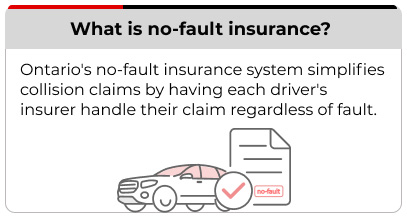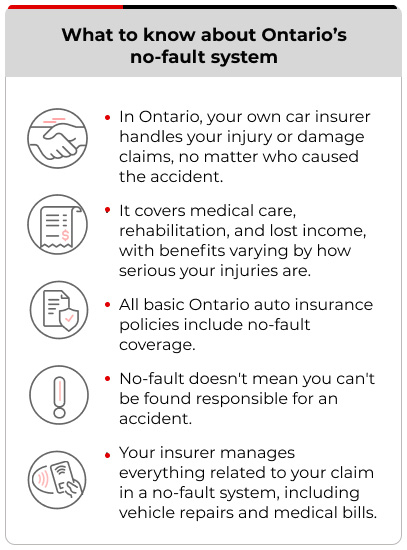
Written by Kayla Jane Barrie Updated on Aug 25, 2025 5 mins read

The no-fault insurance system has been adopted in Ontario and many provinces across Canada to help simplify the claims process.
Let’s be clear about one thing, it does not mean you won’t be found at-fault if you are involved in an accident.
Since you deal solely with your insurer, the claims process is quicker, and you are immediately paid out for losses. There is also no need to go to court and sue the at-fault drivers for compensation, saving you time and the hassle of escalating court proceedings.
No-fault insurance (also known as the Ontario Motorist Protection Plan) is a system that outlines how insurers handle claims and simplifies the process for drivers involved in a collision. No-fault means that, regardless of who is at fault for an accident, each driver’s insurer will handle their claim.
Ontario has a no-fault system to help determine fault in automobile accidents. If you are injured or your vehicle is damaged, you will deal directly with your provider regardless of who is at fault. With the latest changes to DCPD, it’s important to understand how your insurer and the other driver involved will come to a settlement.
In a no-fault system, your insurance company provides full medical and rehabilitation benefits (SABS), as well as income replacement and other benefits based on the severity of your injuries. This model eliminates financial compensation for pain and suffering.
The main advantages of driving under a no-fault system are that your claim is usually resolved more quickly, resulting in receiving compensation sooner, and you only communicate with one insurance company: your own.
No-fault insurance is built into all basic Ontario car insurance policies. If you are insured, you don’t need to speak to a provider to add it to your policy; it is added automatically.

The term applies to the process of how each person will handle their claim. Someone will always be fully or partially to blame, and it is the insurer’s responsibility to determine each person’s risk to determine how policies will be impacted.
This happens when each driver takes a percentage of the fault – known as Fault Determination Rules. Insurers will use these guidelines when examining a scenario by referencing the rules and fault to each party involved with the factual circumstances of the event.
Let’s say you were involved in an accident with a distracted driver – your coverage compensates you for the repairs, then requests a claim in the same amount from the driver who caused the accident.
If the policy covers damage caused by the accident, the fault will not affect the eventual payout of the claim, and depending on who is at-fault, their insurance may increase.
This system did not exist prior to 1989. It was introduced to offset the issue of growing liability costs—those making an insurance claim often had to file multiple claims from an accident. This caused issues with drivers, small municipalities, and charities.
In September 1989, following extensive research and consultation, the government announced its intention to introduce no-fault insurance, which came into effect on June 22, 1990. Over the years, various system reforms have been introduced to address new issues, such as insurance fraud.
Many Ontario drivers misunderstand the term “no-fault” and how it impacts their policy.
These misconceptions are false. Despite the misleading name, insurers will always investigate a claim to determine who was responsible according to the Ontario Insurance Act. You may be found to be fully, partially, or share fault with the other driver.
As part of the no-fault system, your insurer will handle all aspects of the claim and reparations. They will:
No-fault benefits drivers mainly because it simplifies and speeds up the process of submitting claims. Here are some of the other benefits of the no-fault system for Ontario drivers:
Despite the system's benefits, some drivers oppose no-fault, claiming that it protects hazardous drivers because the injured person’s insurer must pay for repairs even though the driver was not accountable.

Under the Ontario no-fault system, you will deal directly and be paid out by your insurer for all types of coverage claims, including:
Your insurer will pay out the claim whether you are found to be at fault or not for an accident. You deal directly with your provider for all accident payments.
If you are deemed to be at fault and you have collision coverage, you’ll have to pay the deductible to repair damage to your automobile before your provider pays. Your insurance will likely increase unless you have extra protection, such as accident forgiveness. It will also stay on your driving record for up to six years. If you are not at fault, you will likely not see any increase in your policy cost.
No-fault insurance is meant to simplify the car insurance claims process and speed up paying compensation to drivers involved in accidents.
It depends on the circumstances of your auto accident. If you are the at-fault driver, you will likely be required to pay your car insurance deductible. Your deductible amount varies based on the details of your policy.
All drivers in Ontario, regardless of the insurer or policy, are subject to the same no-fault rules.
Other than in Ontario, Alberta car insurance operates under a different variation of no-fault insurance. No-fault insurance also exists in other provinces, such as Quebec and the Atlantic, but how it operates varies by province.
| Categories | Industry NewsAuto |
|---|---|
| Tags | Auto CoverageFAQsAuto CoverageAuto Claims |
Read our insurance blog to get helpful tips, information and news.
Has your car been totalled in an accident? Is your car a write off? Learn about vehicle write offs for a total loss insurance claim.
Get the facts on Toronto's auto theft problem. We break down the data, reveal the most-stolen vehicles (including the Honda CR-V and Lexus RX 350), and show which neighbourhoods are most affected.
Dive into the world of auto theft with our blog on the most stolen cars in Canada. See the most stolen cars across Canada, including provincial lists for Ontario and Quebec, and learn how high-risk models can affect your car insurance premiums.
Drive safe this winter! Check out these tips for driving in snowy and icy conditions in Ontario. Get other helpful info and FAQs on winter driving.